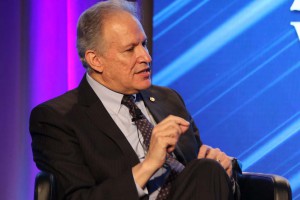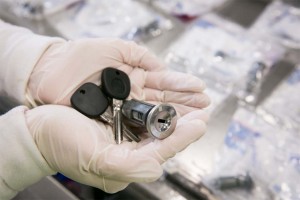Automotive recalls hit an all-time high of 51.2 million in 2015, the second record year in a row that has happened, driven in part by the massive problems with faulty Takata airbags.
The announcement by the National Highway Traffic Safety Administration at this week’s Washington Auto Show comes at a time when automakers and automotive suppliers are being driven to be more proactive in addressing problems, federal regulators showing far less tolerance and levying far larger fines than ever before for safety lapses.
“Part of what has happened is a vigilance in looking for defects,” said Mark Rosekind, the NHTSA Administrator behind the crackdown, adding that, “getting them addressed, has been effective.”
For nearly a decade, between 2005 and 2013, the number of recalls barely topped the 20 million mark, dipping well below the old record 32 million vehicles targeted in 2000.
NHTSA has made it clear to the industry – and public — that it won’t tolerate delays in reporting safety, or moves meant to hide defects from the public. In years past, automakers would often try to address problems on a one-by-one basis, rather than ordering across-the-board recalls. And they have been lax in following the rules on an early warning system designed to flag potential problems.
That latter issue resulted in hefty and, in some cases, record penalties last year for manufacturers including Fiat Chrysler, BMW and Honda. General Motors was fined by both NHTSA and the U.S. Justice Department for waiting a decade to recall faulty ignition switches now linked to over 120 deaths. Toyota also settled with the Justice Dept. for its own safety lapses.
Among those fined in 2015, Japanese supplier Takata has been linked to the recall of nearly 20 million vehicles in the U.S. alone. Airbag inflators that can explode during a crash, potentially sending shards of plastic and metal flying into the passenger compartment, have been linked to nine deaths so far.
(Rosekind warns “a lot more” Takata airbags may soon be recalled. Click Here for the story.)
Despite the fact that more recalls are now being dealt with publicly, Rosekind last week said the surge is not something to celebrate, but something that shows how much further the auto industry has to go to meet expected levels of safety.
One of the biggest challenges comes from a trend reshaping the way automakers engineer and build their vehicles. In a push to increase so-called economies of scale, lowering production costs in the process, they now attempt to share underlying components on as many vehicles as possible. That not only means using them on different models, but between manufacturers. So, a defect now can impact millions, rather than thousands, of vehicles.
NHTSA itself came under fire for failing to isolate problems like the GM ignition switch and Takata airbag issues. That has led to sweeping changes within the organization itself, led by Rosekind who signed on as administrator in December 2014.
Meanwhile, Congress authorized the agency to triple the maximum fine it can levy, from $35 million to $105 million, as part of the new federal transportation act. But Rosekind said during an appearance in Detroit last week that he would prefer not to use this “big stick.” And, indeed, he and his boss, Transportation Secretary Anthony Foxx, announced a series of steps aimed at forging a more cooperative and proactive relationship with the industry.
Last Thursday, during an appearance at the Detroit Auto Show, Foxx announced a request by the Obama Administration for $4 billion to fund the start-up of a national connected-car network. He also said NHTSA would work with manufacturers to ease rules, when necessary, that might delay or block development of new autonomous vehicle technology.
A day later, Fox and Rosekind returned to the North American International Auto Show, standing side-by-side with CEOs and other executives from 18 major automakers to announce the formation of a new safety consortium. Its goal will be to get new, life-saving technology onto the road faster than would be possible using traditional legislative mandates.
(For more on the new safety consortium, Click Here.)
The number of fatalities plunged by 40% from the peak years of the 1970s to an all-time low of 32,675 deaths in 2014 – despite three times more vehicles on U.S. roads being driven far more miles. But fatalities rose in 2015, according to preliminary data. That has increased the sense of urgency to introduce new technologies such as Electronic Stability Control.
Mandated on all U.S. vehicles since 2009, the trade organization the Insurance Institute for Highway Safety has credited stability control with being the most important breakthrough since seatbelts began being mandated in the 1970s.
“Since the Model T, vehicle safety has focused on assuming that some crashes are inevitable, and designing to reduce the carnage,” Rosekind said during this appearance at the Washington Auto Show on Thursday. “Today, it is not science fiction to suggest that technology could, sometime in the not-too-distant future, help us avoid the vast majority of fatal crashes.”
But the industry alone can’t solve all of the country’s automotive safety problems, the NHTSA chief stressed. Even where automakers move quickly to address a defect, large numbers of owners fail to get their vehicles fixed. Response rates seldom top 70% and often fall to less than 40%. But even seemingly minor issues can be deadly, noted safety advocated Clarence Ditlow, director of the Center for Automotive Safety.
NHTSA is pressing makers to take steps to encourage consumers to respond more frequently. GM and Honda, for example, have even turned to incentives to draw owners into dealer repair bays. And new federal rules now require dealers and daily rental fleets to make repairs on recalled vehicles before selling or renting them.
The safety agency also has launched a year-long digital advertising campaign, “Safe Cars, Safe Lives,” to get the message across directly to consumers.
(For more on the White House connected car and autonomous vehicle initiatives, Click Here.)



